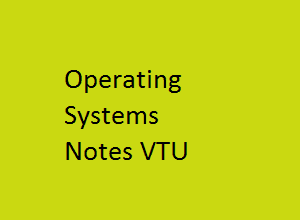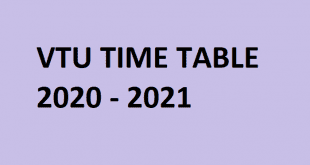Operating Systems VTU Notes Pdf – OS PDF VTU
Here you can download the Operating Systems VTU Notes Pdf – OS PDF VTU of as per VTU Syllabus. Below we have list all the links as per the modules.
Please find the download links of Operating Systems VTU Notes Pdf – OS PDF VTU are listed below:

Operating Systems Notes PDF
Description
In this detailed guide, you will find comprehensive notes for the subject Operating Systems tailored to the VTU syllabus. These notes are designed to help B. Tech students understand essential concepts in operating systems effectively. The detailed modules cover various aspects from system structures to Linux OS, providing a solid foundation for your studies.
Operating Systems | PDF, Syllabus, Books | B Tech (2025)
Overview OS Notes Pdf
The Operating Systems notes are meticulously structured to cover all key topics required for VTU’s B.Tech syllabus. These notes are available in PDF format, making it easy for students to access and study anytime, anywhere.
The following topics are covered in Operating Systems handwritten Notes
- Introduction to the Operating System
- Process Management
- Process Synchronization
- Deadlocks
- Memory Management
- File System
- Secondary Storage Structures
- The Linux Operating System
Links to download Operating Systems Notes Pdf
Below, you can find the download links for each unit of the Operating Systems notes:
Link: Complete Notes
Link: Part- A Notes
Link: Unit-1
Link: Unit-2
Link: Unit-3
Link: Unit-4
Link: Part- B
Link: Unit-5
Link: Unit-6
Link: Unit-7
Link: Unit-8
OS Notes and Study Material PDF Free Download
You can freely download the OS notes and study materials from the links provided. These PDFs cover the entire syllabus in detail and are perfect for exam preparation.


Unit’s Covered in this OS Notes Pdf
Part A
UNIT – 1: Introduction to the Operating System
- What Operating Systems Do: Learn about the primary functions and roles of operating systems.
- Computer System Organization: Understand the overall structure and organization of computer systems.
- Computer System Architecture: Delve into the various architectures of computer systems and how operating systems fit in.
- Operating System Structure: Explore different structures of operating systems, including monolithic, layered, and microkernel designs.
- Operating System Operations: Gain insight into the operations managed by operating systems such as process management, memory management, and storage management.
- Process Management: An overview of how operating systems handle processes, including process creation, scheduling, and termination.
- Memory Management: Learn about how operating systems manage memory allocation and deallocation.
- Storage Management: Understand the methods used by operating systems to manage storage devices and file systems.
- Protection and Security: Explore the mechanisms for ensuring system protection and security.
- Distributed Systems: Introduction to systems where components located on networked computers communicate and coordinate their actions.
- Special-Purpose Systems: Learn about systems designed for specific tasks, such as real-time systems and embedded systems.
- Computing Environments: Overview of different computing environments supported by operating systems, including desktop, server, and cloud environments.
- Operating System Services: Detailed look at the services provided by operating systems to application programs and users.
- User-Operating System Interface: Understand how users interact with operating systems through command-line interfaces, graphical user interfaces, and other means.
- System Calls: Learn about the interface between a process and the operating system.
- Types of System Calls: Different types of system calls, including process control, file manipulation, device management, and information maintenance.
- System Programs: Understand programs that provide a convenient environment for program development and execution.
- Operating System Design and Implementation: Explore the principles of designing and implementing operating systems.
- Virtual Machines: Learn about the concept and implementation of virtual machines.
- Operating System Generation: Understand the process of generating an operating system for a specific hardware configuration.
- System Boot: Learn about the process of starting a computer and loading the operating system.
UNIT – 2: Process Management
- Process Concept: Basic concepts related to processes, including process states and process control blocks.
- Process Scheduling: Detailed study of process scheduling, including types of scheduling (preemptive and non-preemptive) and scheduling algorithms.
- Operations on Processes: Learn about various operations performed on processes, such as creation, termination, and inter-process communication.
- Inter-Process Communication: Explore mechanisms for processes to communicate and synchronize their actions.
- Multi-Threaded Programming: Introduction to multi-threading, its advantages, and various multi-threading models.
- Overview: Basics of multi-threading.
- Multi-threading Models: Different models of multi-threading, such as many-to-one, one-to-one, and many-to-many.
- Thread Libraries: Libraries that provide programmer with API for creating and managing threads.
- Threading Issues: Common issues encountered in multi-threaded programming, such as race conditions and deadlocks.
- Process Scheduling:
- Basic Concepts: Fundamental concepts of process scheduling.
- Scheduling Criteria: Criteria used to evaluate scheduling algorithms.
- Scheduling Algorithms: Detailed study of various scheduling algorithms, including FCFS, SJF, Priority, Round Robin, and Multilevel Queue.
- Multiple-Processor Scheduling: Scheduling in systems with multiple processors.
- Thread Scheduling: Scheduling issues related to threads.
UNIT – 3: Process Synchronization
- The Critical Section Problem: Understanding the problem of ensuring that no two processes are in their critical sections simultaneously.
- Peterson’s Solution: Learn about Peterson’s solution for mutual exclusion.
- Synchronization Hardware: Explore hardware support for process synchronization.
- Semaphores: Introduction to semaphores and their use in solving synchronization problems.
- Classical Problems of Synchronization: Study classical synchronization problems such as the bounded buffer problem, the readers-writers problem, and the dining philosophers problem.
- Monitors: Understand the concept of monitors as a high-level synchronization construct.
UNIT – 4: Deadlocks
- Handling Deadlocks: Techniques for handling deadlocks in operating systems.
- Deadlock Prevention: Strategies to ensure that the system will never enter a deadlock state.
- Deadlock Avoidance: Methods to avoid deadlocks by careful resource allocation.
- Deadlock Detection: Techniques for detecting deadlocks.
- Recovery from Deadlock: Methods to recover from deadlock situations.
Part B
UNIT – 5: Memory Management
- Background: Basic concepts of memory management.
- Swapping: Introduction to the process of swapping and its role in memory management.
- Contiguous Memory Allocation: Methods of allocating contiguous blocks of memory.
- Paging: Detailed study of paging, including page tables and page replacement algorithms.
- Structure of Page Table: Different structures of page tables, including hierarchical, hashed, and inverted page tables.
- Segmentation: Introduction to segmentation as a memory management technique.
- Virtual Memory Management: Advanced concepts in virtual memory management.
- Background: Overview of virtual memory.
- Demand Paging: Concept of demand paging and page replacement.
- Copy-on-Write: Technique used to efficiently manage process creation.
- Page Replacement: Various page replacement algorithms, such as FIFO, LRU, and Optimal.
- Allocation of Frames: Methods for allocating frames to processes.
- Thrashing: Understanding the problem of thrashing and how to control it.
UNIT – 6: File System
- File Concept: Basic concepts of files and file systems.
- Access Methods: Different methods for accessing files.
- Directory Structure: Study of various directory structures, such as single-level, two-level, tree-structured, and acyclic-graph directories.
- File System Mounting: Process of mounting file systems.
- File Sharing: Techniques and issues related to file sharing.
- Protection: Mechanisms for protecting files.
- Implementing File System: Detailed look at the implementation of file systems.
- File System Structure: Overall structure of a file system.
- File System Implementation: Techniques for implementing file systems.
- Directory Implementation: Methods for implementing directories.
- Allocation Methods: Different methods for allocating space to files, such as contiguous, linked, and indexed allocation.
- Free Space Management: Techniques for managing free space on storage devices.
UNIT – 7: Secondary Storage Structures, Protection
- Mass Storage Structures: Study of various mass storage structures.
- Disk Structure: Understanding the structure of disks.
- Disk Attachment: Methods for attaching disks to the system.
- Disk Scheduling: Techniques for scheduling disk operations.
- Disk Management: Management of disk storage.
- Swap Space Management: Techniques for managing swap space.
- Protection:
- Goals of Protection: Objectives of protection mechanisms.
- Principles of Protection: Basic principles of protecting resources.
- Domain of Protection: Concepts of protection domains.
- Access Matrix: Representation of access rights.
- Implementation of Access: Methods for implementing access control.
UNIT – 8: The Linux Operating System
- Linux History: Overview of the history of the Linux operating system.
- Design Principles: Basic design principles of Linux.
- Kernel Modules: Introduction to kernel modules in Linux.
- Process Management: Study of process management in Linux.
- Scheduling: Scheduling algorithms used in Linux.
- Memory Management: Memory management techniques in Linux.
- File Systems: Overview of file systems in Linux.
- Input and Output: Management of input and output in Linux.
- Inter-Process Communication: Techniques for inter-process communication in Linux.
OS Notes Pdf from VTU
These notes are tailored specifically to the VTU syllabus, ensuring that you have the right information and insights to excel in your Operating Systems course.
Always Choose Smartzworld to download OS Notes PDF
Smartzworld is your go-to platform for downloading high-quality, reliable, and comprehensive notes for your engineering courses. They provide up-to-date and accurate materials that are essential for your academic success.
DOWNLOAD NOW
Benefits of FREE OS Handwritten Notes PDF
- Comprehensive Coverage: Covers all essential topics as per the VTU syllabus.
- Accessible: Available in PDF format for easy download and access.
- Detailed Explanations: Each topic is explained in detail for better understanding.
- Free of Cost: All notes are available for free, ensuring no financial burden on students.
Conclusion
The Operating Systems Notes for VTU students are an invaluable resource for understanding and mastering the concepts of operating systems. These notes provide detailed explanations, practical examples, and comprehensive coverage of all topics required by the VTU syllabus. By utilizing these notes, you can effectively prepare for your exams and deepen your understanding of operating systems.
FAQs
Q1. Where can I download the Operating Systems Notes Pdf?
You can download the notes from the provided links for each unit or the complete set from Smartzworld.
Q2. How to download the OS Notes Pdf?
Simply click on the download links provided for each unit or the complete notes.
Q3. How many modules are covered in OS Notes Pdf?
The notes cover a total of eight modules, divided into Part A and Part B.
Q4. Topics Covered in OS Notes Pdf?
Topics range from basic system structures to advanced Linux OS concepts.
Q5. Where can I get the complete OS Handwritten Notes pdf FREE Download?
The complete set of notes can be downloaded for free from Smartzworld using the provided links.
Q6. How to download OS Handwritten Notes pdf?
Click on the specific unit links or the complete notes link to download the PDFs.
Q7. How to Download FREE OS Notes PDF?
Visit Smartzworld and use the download links provided to get your free notes.



